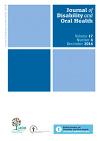Journal of Disability and Oral Health

- Cover Date:
- December 2016
- Print ISSN:
- 1470-8558
- Vol:
- 17
- Issue:
- 4
An evaluation of a blended intravenous cannulation teaching method in dentistry
Heidari et al.: Blended intravenous cannulation teaching
Abstract
Introduction: Traditional teaching consists of face-to-face interaction whilst online uses digital media allowing
learner control over the location, time and pace of their learning. Literature in intravenous (IV) cannulation training
suggests blended teaching, essentially a combination of traditional and online teaching, may be effective. Using
both teaching methods avoids the social isolation of online learning and an opportunity to clarify any ambiguity
while still retaining the ability for the learner to revisit their knowledge and to assess it, to become a self-paced
learner and have easy access to the learning material. Aim: To evaluate a newly introduced teaching method (blended learning) in intravenous cannulation subject for ï¬nal year dental undergraduate students (BDS 5) studying at King’s College London Dental Institute (KCLDI). Method: Longitudinal cohort study. Participants completed traditional venepuncture training followed by e-learning. Upon completion of each type of learning the students rated their conï¬dence in the technique and their felt need for assistance using a 100mm Visual Analogue scale.
Results: Ninety-two BDS 5 dental students (87% of all students in the cohort) participated. There were more
female (55, 60%) students than male. Students reported increased self-conï¬dence and decreased perceived need
for assistance after having the blended learning in intravenous cannulation training in comparison to the traditional
training alone (p≤0.05). There were no statistically differences between the genders. Conclusion: Blended learning in IV cannulation among ï¬nal year dental undergraduate students signiï¬cantly increased self-conï¬dence and decreased felt need for assistance.
Key words: e-Learning, intravenous cannulation, training, education, teaching methods, blended learning.
doi: 10.443/JDOH/Heidari_04
- Article Price
- £15.00
- Institution Article Price
- £
- Page Start
- 150
- Page End
- 153
- Authors
- E Heidari, B Kerr, S Rana, J T Newton
Articles from this issue
- Title
- Pg. Start
- Pg. End
- The use of lateral oblique radiographs in dental treatment planning for patients with special needs
- 154
- 158
- A case of status epilepticus in the dental surgery: learning through significant event audit
- 159
- 162
